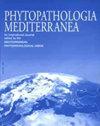Structure analysis of the ribosomal intergenic spacer region of Phaeoacremonium italicum as a study model
IF 1.9
3区 农林科学
Q2 AGRONOMY
引用次数: 2
Abstract
Increasing recognition of novel Phaeoacremonium species, and their recent taxonomic reassignment through phylogeny based on the β-tubulin and actin genes, have highlighted the presence of paraphyly, intraspecific variation, and incongruence of some Phaeoacremonium species. This study investigated the intergenic spacer rDNA regions of a representative collection of 31 Phaeoacremonium italicum strains, and compared their structures with those of the closest related species, Phaeoacremonium alvesii and Phaeoacremonium rubrigenum. These intergenic spacer sequences had five categories of repeat elements that were organised into distinct patterns. Morphological analyses of the P. italicum strains provided a more detailed description of P. italicum. The phylogenetic tree constructed using the intergenic spacer sequences compared with that obtained by combined analysis of β-tubulin and actin sequences indicated that the intergenic spacer rDNA region distinguished intraspecific and interspecific variations. Further molecular studies are required to determine whether intergenic spacer sequences can improve precision in defining Phaeoacremonium phylogeny, and prevent misidentification and the introduction of vague species boundaries for the genus.作为研究模型的意大利白棘球蚴核糖体基因间间隔区结构分析
对新的Phaeoacremonium物种的日益认识,以及最近通过基于β-微管蛋白和肌动蛋白基因的系统发育对其进行的分类学重新分配,突出了一些Phaeoacrmonium物种存在着系旁变异、种内变异和不协调。本研究研究调查了31株具有代表性的褐尖藻菌株的基因间间隔区rDNA区域,并将它们的结构与亲缘关系最密切的物种——alvesii褐尖藻和红色褐尖藻的结构进行了比较。这些基因间间隔序列有五类重复元件,它们被组织成不同的模式。对P.italicum菌株的形态学分析为P.italicum提供了更详细的描述。利用基因间间隔区序列构建的系统发育树与β-微管蛋白和肌动蛋白序列的联合分析结果相比较,表明基因间间隔rDNA区区分种内和种间变异。需要进一步的分子研究来确定基因间间隔序列是否可以提高定义Phaeoacremonium系统发育的精度,并防止该属的错误识别和引入模糊的物种边界。
本文章由计算机程序翻译,如有差异,请以英文原文为准。
求助全文
约1分钟内获得全文
求助全文
来源期刊

Phytopathologia Mediterranea
生物-植物科学
CiteScore
4.40
自引率
8.30%
发文量
28
审稿时长
6-12 weeks
期刊介绍:
Phytopathologia Mediterranea is an international journal edited by the Mediterranean Phytopathological Union. The journal’s mission is the promotion of plant health for Mediterranean crops, climate and regions, safe food production, and the transfer of new knowledge on plant diseases and their sustainable management.
The journal deals with all areas of plant pathology, including etiology, epidemiology, disease control, biochemical and physiological aspects, and utilization of molecular technologies. All types of plant pathogens are covered, including fungi, oomycetes, nematodes, protozoa, bacteria, phytoplasmas, viruses, and viroids. The journal also gives a special attention to research on mycotoxins, biological and integrated management of plant diseases, and the use of natural substances in disease and weed control. The journal focuses on pathology of Mediterranean crops grown throughout the world.
The Editorial Board of Phytopathologia Mediterranea has recently been reorganised, under two Editors-in-Chief and with an increased number of editors.
 求助内容:
求助内容: 应助结果提醒方式:
应助结果提醒方式:


